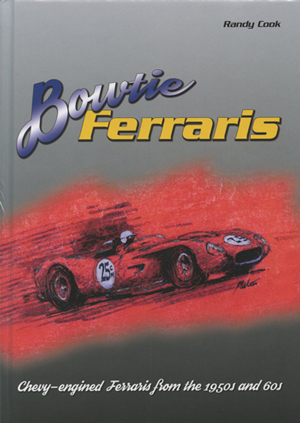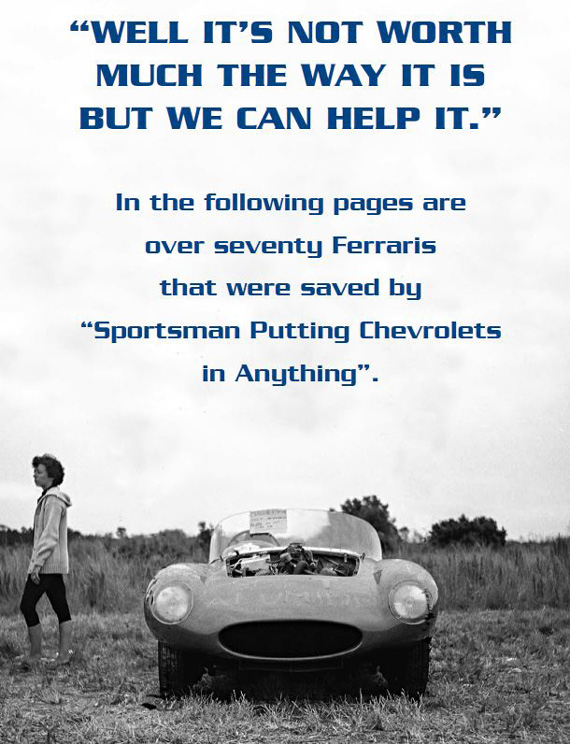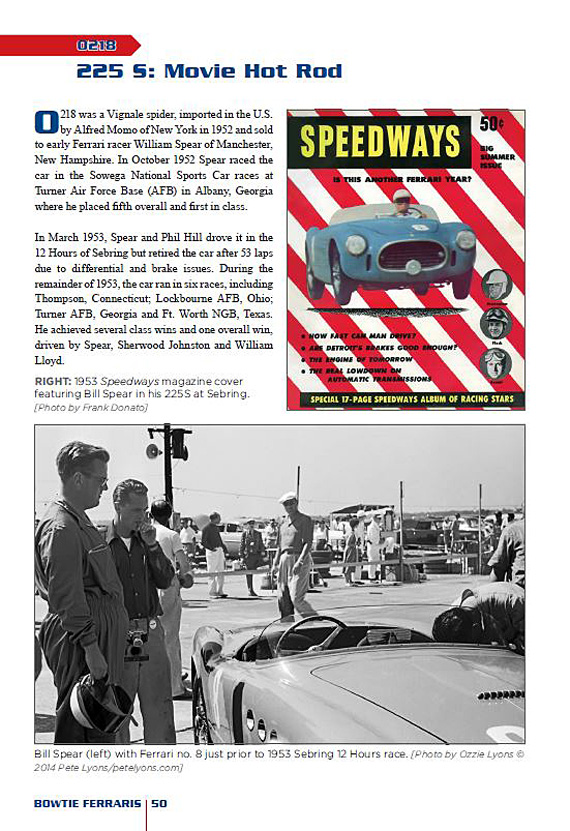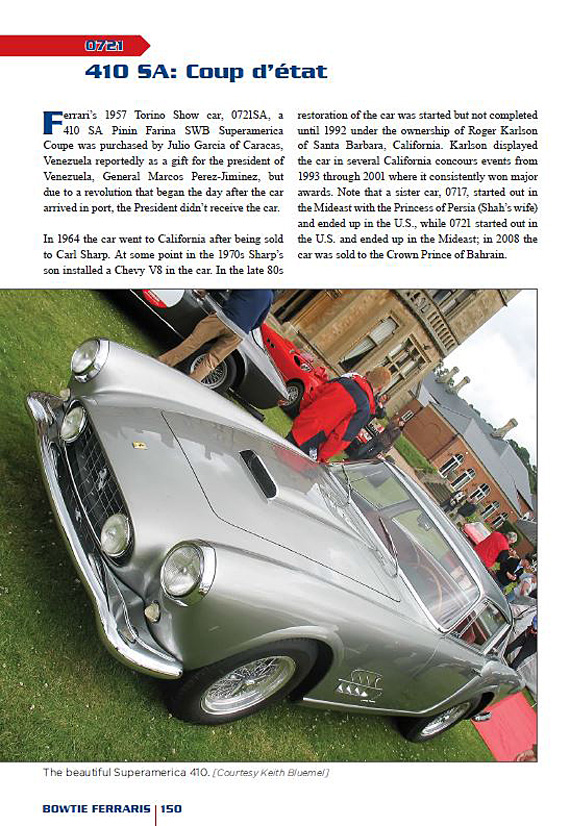By Brandes Elitch
 Bowtie Ferraris:
Bowtie Ferraris:
Chevy-engined Ferraris from the 1950s and 60sIn the February 10, 2015 edition of VeloceToday, author Michael Lynch reviews the book called “Bowtie Ferraris, Chevy-engined Ferraris from the 1950’s and 60’s,” written by Randy Cook. Mr. Lynch is very knowledgeable about Ferrari; I am not. During the Monterey Rolex Reunion in August, I met Randy at the Quail Motorsports Gathering show, “The Legend of the Automobile.” I was intrigued why a 250 GT coupe would have American Racing mags, and when I looked inside and saw the shifter, I knew that there was an American V8 under the hood.
He saw me looking and came up to explain things. When he finished showing me the car, he said, “You know, I have written a book about these cars.” At first, I was taken aback: how many Ferraris could there be with American motors? And why would somebody do this? Now, having read the book, I am once more humbled by my own ignorance, in this case why this is such an important part of the Ferrari story in the US.
Ferrari built only 933 cars in the period 1947-1959. Randy profiles 71 of these cars in the book in serial number order, roughly eight percent of total production, and a much higher number of all cars that came to the US. The research here must have taken years. The bibliography lists 11 interviews, 26 books consulted, and various magazine sources, in addition to 79 acknowledgements. It is an extraordinary piece of research. Randy has provided rare photos of many cars, and our own VeloceToday photographer Hugues Vanhoolandt has quite a few of his photos there as well.
There is no question that many, if not most of the cars profiled, including some of the most famous racecars of the period (e.g. the 1958 TR 250 which won at Le Mans), would not exist today were it not for the second lease on life they got with the conversion. The foreword is written by Toly Arutunoff, who says, “It’s exotic, it’s foreign, and we can help it,” the motivation behind many of the original owners, and it turns out the same mantra I have for collecting cars myself. Today, we forget that back in the fifties, if you didn’t have a connection at the factory, you couldn’t get parts to fix a blown Ferrari motor, at least not in a timely and affordable manner. Many if not most of these cars were used for racing, which is where engines fail. Randy quotes writer Thor Thorson, who nicely summarizes the situation, “…we lose track of the fact that these cars were once simply disposable weapons (on the track)…the real warriors were bashed, crashed, bent, blown up, and jury rigged back together to make the next race, over and over until they were more or less thrown away.”
I asked my friend Craig Sparkes from the Automotive History Preservation Society (www.ahpsoc.org) why the Chevrolet motor was so ubiquitous, given that the Chrysler “hemi” of the period 1951-1958, as provided in the Imperial and New Yorker, was more of a high performance motor. He provided the following two charts as a basis for comparison.
Chrysler 331-354 (early hemi) Chevy small block
Width: 32.125 inches 20.5 inches
Height (oil pan to air cleaner): 36.5 inches 29.42 inches
Length (trans mounting to fan): 36.75 inches 27 inches (swp)
Weight Dry: 710 pounds 575 pounds
Weight fully dressed: 960 pounds 650 pounds
From looking at this, it is obvious that one reason that the Chevy was so ubiquitous was simply that it fit in the engine compartment! Weight also was a factor. Ford did not have a motor comparable to the 1955 Chevy V8 until seven years afterwards, so they were out of contention. Simply put, the Chevy motor was “powerful, trustworthy, and available,” and it fit! The Ferrari chassis was narrow and could not support a bigger motor without considerable reengineering.
There are a few themes that come up in reading the book.
The most extraordinary fact is how so many of the cars were re-united with their original motors, in some cases forty years later. It would appear that some clairvoyant individuals acquired last year’s racing motor for next to nothing and then had the presence of mind to keep it on the shelf for the ensuing decades. I wish I had thought of that.
The second is how many cars have been completely restored to their original specification (some cars were rebodied one or more times during this period).
The name of the English firm DK Engineering comes up multiple times. They must have been the pre-eminent restoration facility for the early Ferraris, in some cases having to almost recreate a whole car from bits and pieces.
The name Ed Niles comes up again and again as a savior of these early cars. Once again, it shows that one person can make a difference, and he did in those early years.
In most cases, Randy is able to track the individual owners of each car, including roughly the time periods when they owned it, as well as the particular racing history associated with each car.
Mr. Lynch closes his article by asking, “Are there enough non-Chevy transplants into Ferrari to make another book?” This is the question I posed to Randy after reading the book. Here is his reply.
“While researching this book, I found 13 Ford, 3 Buick, 1 Chrysler, and 2 Offy powered Ferraris, plus one each Maserati and Mercedes-Benz powered Ferrari. I also found 5 more Chevy powered Ferraris. All of these will be in the next book. I’m also featuring a couple of 250 GTE’s, and 330’s, and listing serial numbers of others known to have been converted. About half a dozen of the converted cars in the books are missing today.”
I asked Randy about the reaction to the book. He replied that the reaction has been generally favorable. The biggest surprise is how well it has been received in Europe and England. Some people have asked why he has not included later Ferraris, such as the 250 GTE and the 330. His response to this is that in the first book he wanted to concentrate on cars with a race history and low production numbers, and to maintain the focus of the book.
Finally, I asked him when the next book, entitled Blue Oval, et al, Ferraris will be out, and he said that he is shooting for January, 2016, hopefully. I am looking forward to reading it.




I really look forward to reading this book. In 1970 when I lived in Laguna Beach, CA, I had a lovely Vignale bodied 166 coupe with a the typical small block Chevy of the day. I sold it in 1972 to a local and have no idea where went from there. Hopefully I will find this old friend in this book.
Randy has no more copies of the Bowtie book and I’m not sure where you can get one. Try a Googling to see if any booksellers have it.
Pete
I have a few copies of the book left, contact me via email at oldsaabracer@aol.com
Autobooks-Aerobooks in Burbank, CA has a few left the last time I checked.
Hortons Books in England has copies available as does Libreia dell’ Automobile in Milano, Italy.
My late father (Lee Lilley) told me that he installed a Chevy engine in a Ferrari in the early 60s. He explained that it was nearly impossible to get replacement engine parts back then. I didn’t think to ask what car it was or who owned it.
To Jay Lilley- I took the photo of the Ferrari with the “For Sale” sign at the header of this week’s website at the Cocoa-Titusville Airport at an SCCA Regional on May 28-29, 1960. I attended a number of Central Florida Region events in the late 1959s-early 1960s, and it’s the only time I saw this car. Could this be the car in which your dad installed a Chevy V-8 engine? Feel free to contact me at jeff.allison@comcast.net.